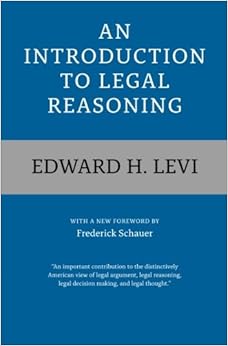Jurisprudence
 The jurisprudential canon is vast and difficult. One excellent starting point is Edward H. Levi’s An Introduction to Legal Reasoning (1949), which deals, in a clear and straightforward fashion, with fundamental questions about legal reasoning, precedent, and statutory and constitutional interpretation.
The jurisprudential canon is vast and difficult. One excellent starting point is Edward H. Levi’s An Introduction to Legal Reasoning (1949), which deals, in a clear and straightforward fashion, with fundamental questions about legal reasoning, precedent, and statutory and constitutional interpretation.
Another good introduction, well written and accessible, is Benjamin N. Cardozo’s The Nature of the Judicial Process (1921), which provides the classic (though by no means universally accepted) account of how judges decide cases.
Karl Llewellyn’s The Common Law Tradition: Deciding Appeals (1960) offers a wealth of insights into legal history, legal theory, and the craft of lawyering.
Robert Cover’s Justice Accused: Antislavery and the Judicial Process (1975) is a very readable and extremely valuable examination of the competing claims of law and morality as seen in the historical context of the nineteenth century judicial battle over the legitimacy of slavery.
Lon Fuller’s The Case of the Speluncean Explorers (available through HeinOnline with L&C login), 62 Harvard L. Rev. 616 (1949), which examines various jurisprudential schools through mock opinions in a hypothetical case, is another classic introduction to the field. Peter Suber's The Case of the Speluncean Explorers: Nine New Opinions (1998), available in Boley Law Library, is an updated print book featuring the original article, plus nine new opinions.
Students interested in less accessible but foundational reading in jurisprudence might consider H.L.A. Hart’s The Concept of Law (3d ed. 2012), a basic organizing text in the field; Richard Posner’s Economic Analysis of Law (9th ed. 2014), arguably even more influential than Hart; Jerome Frank’s landmark Law and the Modern Mind (1930), the first serious effort to study the implications of psychology for legal theory; Ronald Dworkin’s Law’s Empire (1986), a very influential (though ultimately somewhat dissatisfying) effort to provide a model for sound judicial decision-making; Martha Minow’s Making All the Difference: Inclusion, Exclusion, and American Law (1990), a landmark examination of the way in which law reinforces arbitrary social, racial, and gender lines; Catherine MacKinnon’s Toward a Feminist Theory of the State (1989) and Robin L. West’s The Difference in Women’s Hedonic Lives: A Phenomenological Critique of Feminist Legal Theory, 3 Wisconsin Women’s Law J. 81 (1987), two extremely important works of feminist legal theory; Roberto Mangabeira Unger’s The Critical Legal Studies Movement (1986), a good introduction to an influential leftist critique of American law and society; Owen M. Fiss’s Objectivity and Interpretation, 34 Stanford Law Rev. 739 (1982), an excellent introduction to problems in legal hermeneutics; Ronald Coase’s The Firm, the Market and the Law (1988), a foundational text in law and economics; and Richard Delgado and Jean Stefanic’s Critical Race Theory: An Introduction (2001), or Patricia William’s The Alchemy of Race and Rights (1991), two important works in critical race theory.